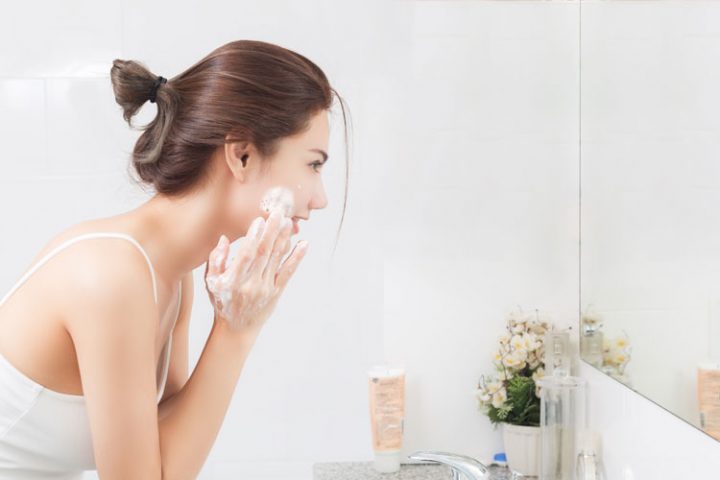
It seems the market has been recently flooded with a massive influx of different types of facial cleansers. Whether it’s foams, gels, oils, scrubs or balms, the ‘cleanser’ category represents a massive and rapidly growing sector of our skincare market.
WHAT TO LOOK FOR
WATER BASED CLEANSERS
Water based cleansers containing surfactants attract oil and impurities from the skin so they can be easily removed from the skin surface. This type of cleanser includes foaming gels and non-foaming lotions.
Foaming cleansers, such as Synergie Skin UltraCleanse, are ideal for virtually every skin type including normal, combination and acne prone skin.
Non-foaming lotion cleansers, such as Synergie Skin BioCleanse, are called oil-in-water emulsions. These contain a lower level of surfactant and are recommended for dry or mature skin. BioCleanse has been specifically created with a mild, low foaming milk formula that is gentle on fragile and dry skin.
The optimal pH for any water based cleanser is around 5.6 (slightly acidic). This is the natural pH of skin so irritation is minimised and our normal acid mantle is maintained. A good facial cleanser must be mild and not disrupt the natural barrier function of the skin.
MICELLAR WATER
What exactly are these elusive ‘micelles’? Micelles are ball-shaped clusters of surfactant molecules, with the water-loving heads all around the outside (where the water is) and oil-loving tails pointing inwards in the middle of the ball and away from the water outside. These micelles break up in contact with skin and act like magnets to attract and lift dirt, oil and makeup from the skin.
Micellar cleansing waters, such as Synergie Skin Micellution, effectively remove traces of makeup, oil build-up and impurities without stripping the skin. There’s no need to rinse, making it the perfect on-the-go cleanser.
POWDER CLEANSERS
Powder cleansers are an emerging trend that originated from Japan. They are simply a powder concentrate that requires the addition of water to create a cleansing foam. Powder cleansers, such as Synergie Skin Cleansing Dust, have the benefit of a longer shelf life and are very convenient for travelling as there are no leakage risks or carry-on liquids. Our Cleansing Dust has been formulated without any fragrance or added colours, making it ideal for the most sensitive of skin.
EXFOLIATING CLEANSERS
Exfoliation is a necessary element of all skincare routines. I do not believe that adding a chemical exfoliating agent such as lactic or salicylic acid to a cleanser will be as effective. Acid exfoliants require a period of time to remove dead skin cells and these ingredients should be only be included in products which remain on the skin surface for a longer period.
Physical exfoliants, however are a better choice for rinse off products, provided the particles are non-irritating and are suited to a skin type. Corundum crystals, found in Synergie Skin MediScrub are an excellent choice for most skin types. Rice powder exfoliation, however, is a better choice for those with more sensitive skin, which we include in Synergie Skin Cleansing Dust.
WHAT TO AVOID
MICROBEAD CONTROVERSY
Microbeads may be microscopic, but they are causing a stir in the beauty industry and creating serious problems for our aquatic environment. Commonly added to facial cleansers, these tiny plastic beads serve no benefit to the skin and are used as cheap alternatives to effective mineral and plant based exfoliants. Click here to read more on me discussing Microbeads.
BAR SOAPS
Bar soaps exhibit a pH of around 9 and are generally too harsh to be used on the facial skin. They are effective at stripping oil, dirt and impurities, but often result in skin irritation and destroying the natural acid mantle.
OIL CLEANSERS
Oil cleansing is a common fad in the cosmetic industry, based on the premise that ‘oil dissolves oil’. A layer of oil on the surface of the skin will prevent penetration of your important water-based serum. Facial oils and moisturisers containing oil should be the final step in your skin care routine and NOT the initial step.
ACTIVE INGREDIENTS IN CLEANSERS
Cleansers are only in contact with the face for an average of twenty seconds and then are simply washed down the drain. Adding active ingredients in cleansers, such as AHA and BHA exfoliants, vitamins or peptides, is unnecessary and a waste of money as there is very little time for these active ingredients to work on the deeper layers of the skin if they are washed off in a few seconds! If actives are added to a cleanser formula they must be rapidly penetrating.
KEY ADVICE
Remember, cleansing is a vital step in your skincare routine, and is the preparation for your other products. A clean canvas is essential before adding the active ingredients that truly make a visible difference.
- Choose a cleanser that is best suited to your skin type and lifestyle
- Don’t waste your money on cleansers with unnecessary active ingredients
- Don’t get caught up on ‘fad cleansing rituals’
- Avoid soaps and cleansers and harsh ingredients such as artificial fragrance and sulfates
- Avoid cleansers and exfoliants with synthetic microbead technology
Not sure what products are suitable for your skin type? Head to our Analyse Your Skin quiz to find your routine – your skin confidence begins here.
